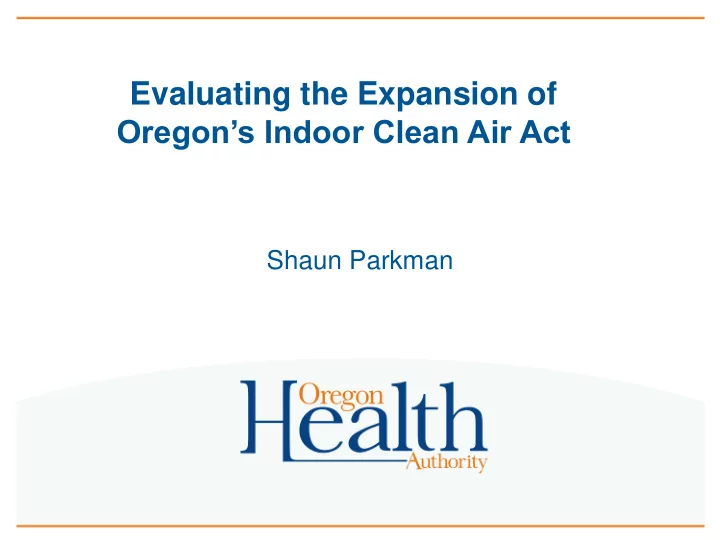

Evaluating the Expansion of Oregon’s Indoor Clean Air Act Shaun Parkman
Outline 1. Define the policy 2. Timeline for policy process 3. Why we are interested in evaluating this policy 4. How we are evaluating the policy process
House Bill 2546 3
Defined “Inhalant delivery systems” • IDS are devices that can be used to deliver nicotine, cannabinoids and other substances, in the form of a vapor or aerosol • Includes e-cigarettes, vape pens, e-hookah and other devices • These are not considered tobacco products under the new law
Prohibits use in indoor public places 5
6
Bans the sale, purchase or use of electronic cigarettes for those under the age of 18
Rule-writing authority Packaging that Child-resistant doesn’t appeals to Labeling packaging minors
Prohibits all inhalants Nicotine Cannabinoids Herbal hookah
HB 2546 timeline Late 2014 / Early 2015 2014 Secular trends E-cigarette awareness increases, CDC Legislative session MMWR on youth use, local ICAA Two e-cigarette bills were introduced, but did not pass expansions, marijuana legalization 2014 2015 Post session Legislative session E-cigarette workgroup formed with Bills introduced in both diverse membership to draft pre-session chambers with minor bill and agree on minimum needs amendments, nothing was removed
Why are we evaluating this policy process?
Success! Novel definition that accounted for marijuana Remained intact; no exemptions for vape shops Diverse group of stakeholders involved
Policy evaluation overview “ The systematic collection and analysis of information ” to make judgments about contexts, activities, characteristics, or outcomes of the policy process
Goals for policy evaluation 1 2 Describe the policy process Document strengths and and lessons learned for other areas for improvement in jurisdictions interested in internal process and cross- tobacco prevention sector collaboration
Although policy evaluation and program evaluation have many similarities, there are some important differences as well...
Attribution
Evaluation advisory group members 6 Members 4 State public health 1 Local public health 1 Lobbyist
Complexity
State Local Lobby
External forces
Shifting strategies and milestones
Lesson learned! Don’t forget the potential importance of secular trends or external forces when evaluating a policy process
Evaluation questions 1 To what extent and effect did state government, local government, and lobbyists collaborate in the policy process? 2 What role did local, state, and national tobacco control infrastructure play in the policy process? 3 What role did secular trends (events out of our control) play in the process? How (if at all) was the system set up to respond to these events?
Key informant interviews
Key informant interviews 15 Stakeholders 6 Lobbyist 6 Legislature 2 Local public health 1 State public health
Timeframe
Policy evaluation Timeframe
Prospective versus retrospective
Lesson learned! Can’t assume only one policy a session on which to focus Limited resources (people and money) to evaluate all policies Stakeholders do not have time during legislative session to participate Requires upfront agreement on policy evaluation focus (role of government in policy process?)
What’s next?
HB 2546 evaluation timeline July September Conduct key Evaluation advisory group informant interviews meeting to review results August October / November Qualitative analysis of key Evaluation report and informant interviews presentation
HB 2546 evaluation timeline July September Conduct key Evaluation advisory group informant interviews meeting to review results August October / November Qualitative analysis of key Evaluation report and informant interviews presentation
Contact information Shaun Parkman shaun.w.parkman@state.or.us
Extra slides
Theory of change versus logic model
Lesson learned! Don’t start with the theory of change model; allow your advisory group to co-develop the policy narrative
Past 30 day use of electronic cigarettes among 11 th graders in Oregon, 2011-2015 E-cigarette use has tripled since 2013 25% 20% 17.1% Past 30 day use of electronic cigarettes 15% 10% 5.2% 5% 1.8% 0% 2011 2013 2015 49
Past 30 day use of tobacco products among 11 th graders in Oregon in 2015 E-cigarette use is higher than any other tobacco product 18% 17% 16% 14% 12% 10% 9% 8% 8% 8% 6% 6% 4% 3% Past 30 day use 2% 2% 1% 0% Electronic Cigarettes Hookah Little cigar Chewing tobacco Pipes Large cigar Dissolvables cigarettes 50
Window of opportunity
Change happens when a window of opportunity opens • Informed decision makers • Stakeholder involvement • Local public health involvement • Partners (traditional and non-traditional) • Social change/secular trends
Recommend
More recommend